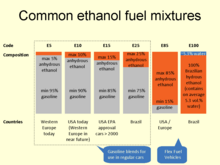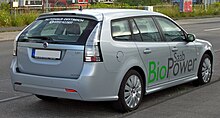
Back Bio-etanol Afrikaans إيثانول حيوي Arabic Биоетанол Bulgarian Bioetanol Catalan سوتەمەنی ئیسانۆل CKB Bioethanol Czech Bioætanol Danish Bioethanol German Bioetanolo Esperanto Etanol (combustible) Spanish
This article has multiple issues. Please help improve it or discuss these issues on the talk page. (Learn how and when to remove these messages)
|


| Part of a series on |
| Renewable energy |
|---|
 |

Ethanol fuel is fuel containing ethyl alcohol, the same type of alcohol as found in alcoholic beverages. It is most often used as a motor fuel, mainly as a biofuel additive for gasoline.
Several common ethanol fuel mixtures are in use around the world. The use of pure hydrous or anhydrous ethanol in internal combustion engines (ICEs) is only possible if the engines are designed or modified for that purpose. Anhydrous ethanol can be blended with gasoline (petrol) for use in gasoline engines, but with high ethanol content only after engine modifications to meter increased fuel volume since pure ethanol contains only 2/3 the energy of an equivalent volume of pure gasoline. High percentage ethanol mixtures are used in some racing engine applications as the very high octane rating of ethanol is compatible with very high compression ratios.
The first production car running entirely on ethanol was the Fiat 147, introduced in 1978 in Brazil by Fiat. Ethanol is commonly made from biomass such as corn or sugarcane. World ethanol production for transport fuel tripled between 2000 and 2007 from 17×109 liters (4.5×109 U.S. gal; 3.7×109 imp gal) to more than 52×109 liters (14×109 U.S. gal; 11×109 imp gal). From 2007 to 2008, the share of ethanol in global gasoline type fuel use increased from 3.7% to 5.4%.[1] In 2011 worldwide ethanol fuel production reached 8.46×109 liters (2.23×109 U.S. gal; 1.86×109 imp gal) with the United States of America and Brazil being the top producers, accounting for 62.2% and 25% of global production, respectively.[2] US ethanol production reached 57.54×109 liters (15.20×109 U.S. gal; 12.66×109 imp gal) in May 2017.[3]
Ethanol fuel has a "gasoline gallon equivalency" (GGE) value of 1.5, i.e. to replace the energy of 1 volume of gasoline, 1.5 times the volume of ethanol is needed.[4][5]
Ethanol-blended fuel is widely used in Brazil, the United States, and Europe (see also Ethanol fuel by country).[2] Most cars on the road today in the U.S. can run on blends of up to 15% ethanol,[6] and ethanol represented 10% of the U.S. gasoline fuel supply derived from domestic sources in 2011.[2] Some flexible-fuel vehicles are able to use up to 100% ethanol.
Since 1976 the Brazilian government has made it mandatory to blend ethanol with gasoline, and since 2007 the legal blend is around 25% ethanol and 75% gasoline (E25).[7] By December 2011 Brazil had a fleet of 14.8 million flex-fuel automobiles and light trucks[8][9] and 1.5 million flex-fuel motorcycles[10][11][12] that regularly use neat ethanol fuel (known as E100).
Bioethanol is a form of renewable energy that can be produced from agricultural feedstocks. It can be made from very common crops such as hemp, sugarcane, potato, cassava and corn. There has been considerable debate about how useful bioethanol is in replacing gasoline. Concerns about its production and use relate to increased food prices due to the large amount of arable land required for crops,[13] as well as the energy and pollution balance of the whole cycle of ethanol production, especially from corn.[14][15]
- ^ "Towards Sustainable Production and Use of Resources: Assessing Bio fuels" (PDF). United Nations Environment Programme. 16 October 2009. Archived from the original (PDF) on 22 November 2009. Retrieved 24 October 2009.
- ^ a b c Cite error: The named reference
RFAOutlook2012was invoked but never defined (see the help page). - ^ AMIS Market Monitor No. 48 – May 2017, http://www.amis-outlook.org/fileadmin/user_upload/amis/docs/Market_monitor/AMIS_Market_Monitor_Issue_47.pdf
- ^ "Gasoline Gallon Equivalent (GGE) Definition". energy.gov. Retrieved 12 October 2011.
- ^ "Alternative Fuels Data Center – Fuel Properties Comparison" (PDF). Alternative Fuels Data Center. 29 October 2014.
- ^ "Will High-Ethanol Gasoline Ruin Your Car Engine? What to Know About E15". NBC 5 Dallas-Fort Worth (KXAS). 12 April 2022. Retrieved 2 July 2022.
- ^ "Portaria Nº 143, de 27 de Junho de 2007" (in Portuguese). Ministério da Agricultura, Pecuária e Abastecimento. Retrieved 5 October 2008.
- ^ "Anúario da Industria Automobilistica Brasileira 2011: Tabela 2.3 Produção por combustível – 1957/2010" (in Portuguese). ANFAVEA – Associação Nacional dos Fabricantes de Veículos Automotores (Brasil). Archived from the original on 31 May 2013. Retrieved 22 January 2012. pp. 62–63.
- ^ Renavam/Denatran (January 2012). "Licenciamento total de automóveis e comerciais leves por combustível" [Total automobiles and light-trucks registered by fuel] (PDF) (in Portuguese). ANFAVEA. Archived from the original (PDF) on 31 January 2012. Retrieved 21 January 2012. Carta de ANFAVEA 308 pp. 4.
- ^ Abraciclo (27 January 2010). "Motos flex foram as mais vendidas em 2009 na categoria 150cc" (in Portuguese). UNICA. Archived from the original on 5 December 2012. Retrieved 10 February 2010.
- ^ "Produção Motocicletas 2010" (PDF) (in Portuguese). ABRACICLO. Retrieved 5 February 2011.
- ^ "Produção Motocicletas 2011" [2011 Motorcycle Production] (PDF) (in Portuguese). ABRACICLO. Retrieved 21 January 2012.
- ^ "Deforestation diesel – the madness of biofuel" (PDF). Retrieved 27 August 2011.
- ^ Youngquist, W. Geodestinies, National Book Company, Portland, Oregon, p.499
- ^ "The dirty truth about biofuels". Oilcrash.com. 14 March 2005. Archived from the original on 4 December 2009. Retrieved 27 August 2011.